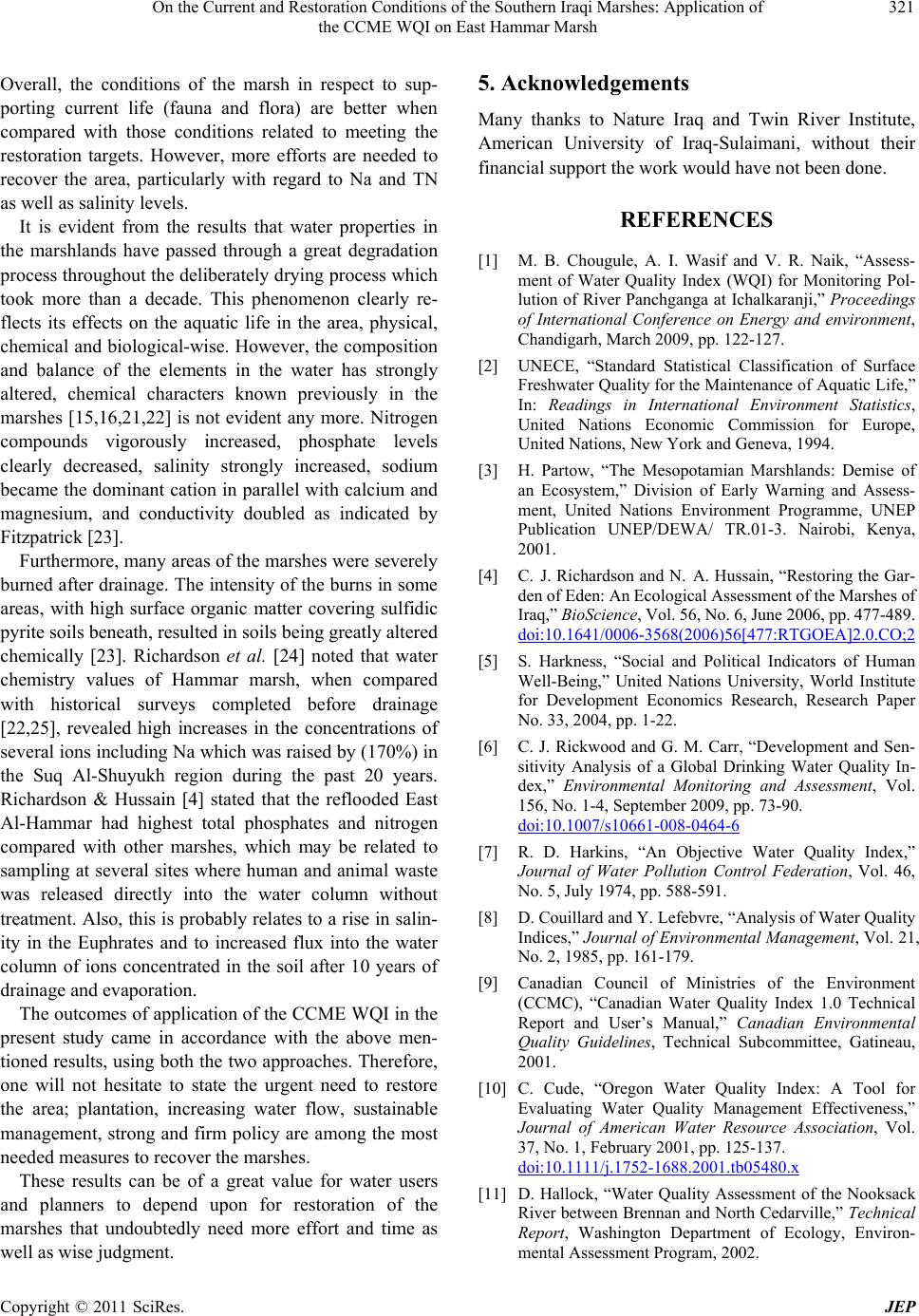
On the Current and Restoration Conditions of the Southern Iraqi Marshes: Application of 321
the CCME WQI on East Hammar Marsh
Overall, the conditions of the marsh in respect to sup-
porting current life (fauna and flora) are better when
compared with those conditions related to meeting the
restoration targets. However, more efforts are needed to
recover the area, particularly with regard to Na and TN
as well as salinity levels.
It is evident from the results that water properties in
the marshlands have passed through a great degradation
process throughout the deliberately drying process which
took more than a decade. This phenomenon clearly re-
flects its effects on the aquatic life in the area, physical,
chemical and biological-wise. However, the composition
and balance of the elements in the water has strongly
altered, chemical characters known previously in the
marshes [15,16,21,22] is not evident any more. Nitrogen
compounds vigorously increased, phosphate levels
clearly decreased, salinity strongly increased, sodium
became the dominant cation in parallel with calcium and
magnesium, and conductivity doubled as indicated by
Fitzpatrick [23].
Furthermore, many areas of the marshes were severely
burned after drainage. The intensity of the burns in some
areas, with high surface organic matter covering sulfidic
pyrite soils beneath, resulted in soils being greatly altered
chemically [23]. Richardson et al. [24] noted that water
chemistry values of Hammar marsh, when compared
with historical surveys completed before drainage
[22,25], revealed high increases in the concentrations of
several ions including Na which was raised by (170%) in
the Suq Al-Shuyukh region during the past 20 years.
Richardson & Hussain [4] stated that the reflooded East
Al-Hammar had highest total phosphates and nitrogen
compared with other marshes, which may be related to
sampling at several sites where human and animal waste
was released directly into the water column without
treatment. Also, this is probably relates to a rise in salin-
ity in the Euphrates and to increased flux into the water
column of ions concentrated in the soil after 10 years of
drainage and evaporation.
The outcomes of application of the CCME WQI in the
present study came in accordance with the above men-
tioned results, using both the two approaches. Therefore,
one will not hesitate to state the urgent need to restore
the area; plantation, increasing water flow, sustainable
management, strong and firm policy are among the most
needed measures to recover the marshes.
These results can be of a great value for water users
and planners to depend upon for restoration of the
marshes that undoubtedly need more effort and time as
well as wise judgment.
5. Acknowledgements
Many thanks to Nature Iraq and Twin River Institute,
American University of Iraq-Sulaimani, without their
financial support the work would have not been done.
REFERENCES
[1] M. B. Chougule, A. I. Wasif and V. R. Naik, “Assess-
ment of Water Quality Index (WQI) for Monitoring Pol-
lution of River Panchganga at Ichalkaranji,” Proceedings
of International Conference on Energy and environment,
Chandigarh, March 2009, pp. 122-127.
[2] UNECE, “Standard Statistical Classification of Surface
Freshwater Quality for the Maintenance of Aquatic Life,”
In: Readings in International Environment Statistics,
United Nations Economic Commission for Europe,
United Nations, New York and Geneva, 1994.
[3] H. Partow, “The Mesopotamian Marshlands: Demise of
an Ecosystem,” Division of Early Warning and Assess-
ment, United Nations Environment Programme, UNEP
Publication UNEP/DEWA/ TR.01-3. Nairobi, Kenya,
2001.
[4] C. J. Richardson and N. A. Hussain, “Restoring the Gar-
den of Eden: An Ecological Assessment of the Marshes of
Iraq,” BioScience, Vol. 56, No. 6, June 2006, pp. 477-489.
doi:10.1641/0006-3568(2006)56[477:RTGOEA]2.0.CO;2
[5] S. Harkness, “Social and Political Indicators of Human
Well-Being,” United Nations University, World Institute
for Development Economics Research, Research Paper
No. 33, 2004, pp. 1-22.
[6] C. J. Rickwood and G. M. Carr, “Development and Sen-
sitivity Analysis of a Global Drinking Water Quality In-
dex,” Environmental Monitoring and Assessment, Vol.
156, No. 1-4, September 2009, pp. 73-90.
doi:10.1007/s10661-008-0464-6
[7] R. D. Harkins, “An Objective Water Quality Index,”
Journal of Water Pollution Control Federation, Vol. 46,
No. 5, July 1974, pp. 588-591.
[8] D. Couillard and Y. Lefebvre, “Analysis of Water Quality
Indices,” Journal of Environmental Management, Vol. 21,
No. 2, 1985, pp. 161-179.
[9] Canadian Council of Ministries of the Environment
(CCMC), “Canadian Water Quality Index 1.0 Technical
Report and User’s Manual,” Canadian Environmental
Quality Guidelines, Technical Subcommittee, Gatineau,
2001.
[10] C. Cude, “Oregon Water Quality Index: A Tool for
Evaluating Water Quality Management Effectiveness,”
Journal of American Water Resource Association, Vol.
37, No. 1, February 2001, pp. 125-137.
doi:10.1111/j.1752-1688.2001.tb05480.x
[11] D. Hallock, “Water Quality Assessment of the Nooksack
River between Brennan and North Cedarville,” Technical
Report, Washington Department of Ecology, Environ-
mental Assessment Program, 2002.
Copyright © 2011 SciRes. JEP